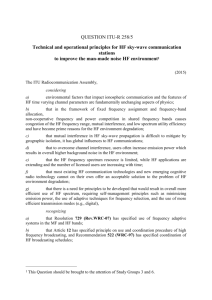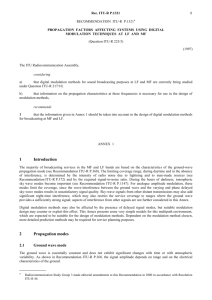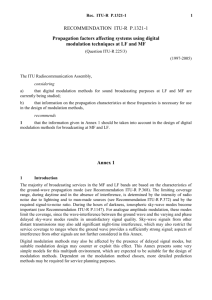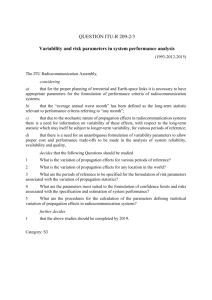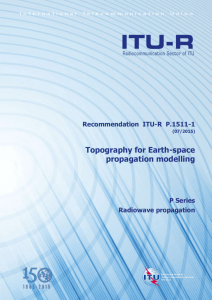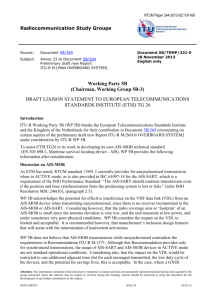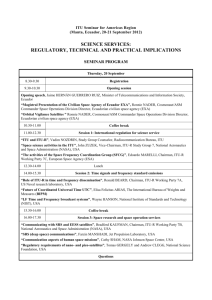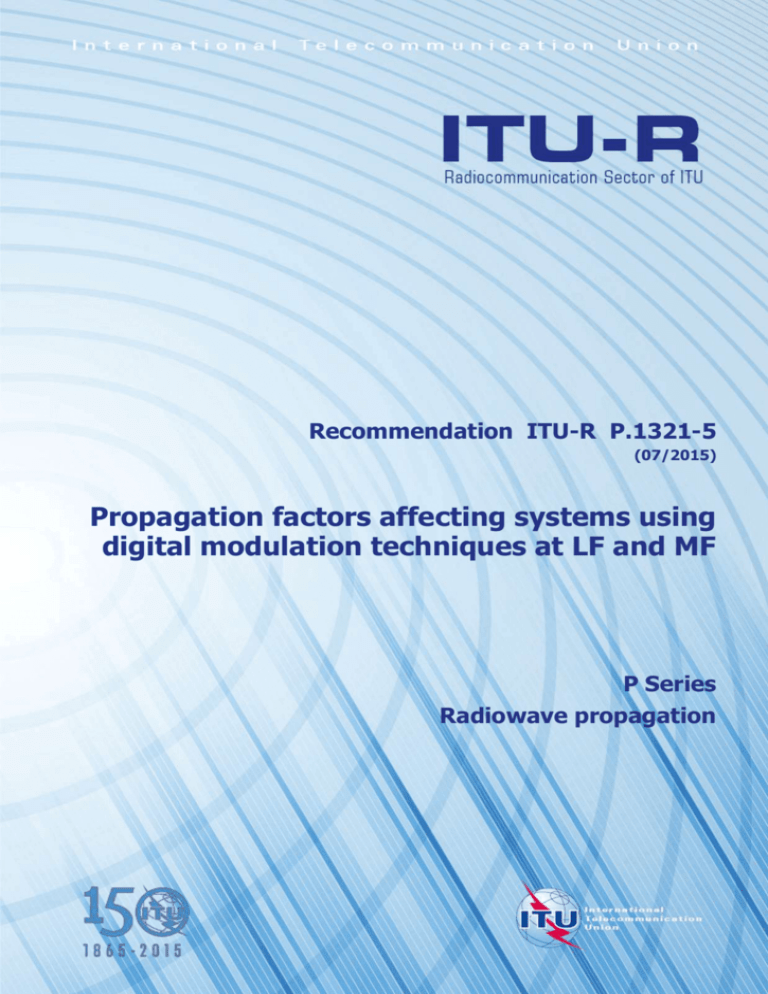
Recommendation ITU-R P.1321-5
(07/2015)
Propagation factors affecting systems using
digital modulation techniques at LF and MF
P Series
Radiowave propagation
ii
Rec. ITU-R P.1321-5
Foreword
The role of the Radiocommunication Sector is to ensure the rational, equitable, efficient and economical use of the radiofrequency spectrum by all radiocommunication services, including satellite services, and carry out studies without limit
of frequency range on the basis of which Recommendations are adopted.
The regulatory and policy functions of the Radiocommunication Sector are performed by World and Regional
Radiocommunication Conferences and Radiocommunication Assemblies supported by Study Groups.
Policy on Intellectual Property Right (IPR)
ITU-R policy on IPR is described in the Common Patent Policy for ITU-T/ITU-R/ISO/IEC referenced in Annex 1 of
Resolution ITU-R 1. Forms to be used for the submission of patent statements and licensing declarations by patent holders
are available from http://www.itu.int/ITU-R/go/patents/en where the Guidelines for Implementation of the Common
Patent Policy for ITU-T/ITU-R/ISO/IEC and the ITU-R patent information database can also be found.
Series of ITU-R Recommendations
(Also available online at http://www.itu.int/publ/R-REC/en)
Title
Series
BO
BR
BS
BT
F
M
P
RA
RS
S
SA
SF
SM
SNG
TF
V
Satellite delivery
Recording for production, archival and play-out; film for television
Broadcasting service (sound)
Broadcasting service (television)
Fixed service
Mobile, radiodetermination, amateur and related satellite services
Radiowave propagation
Radio astronomy
Remote sensing systems
Fixed-satellite service
Space applications and meteorology
Frequency sharing and coordination between fixed-satellite and fixed service systems
Spectrum management
Satellite news gathering
Time signals and frequency standards emissions
Vocabulary and related subjects
Note: This ITU-R Recommendation was approved in English under the procedure detailed in Resolution ITU -R 1.
Electronic Publication
Geneva, 2013
ITU 2013
All rights reserved. No part of this publication may be reproduced, by any means whatsoever, without written permission of ITU.
Rec. ITU-R P.1321-5
1
RECOMMENDATION ITU-R P.1321-5
Propagation factors affecting systems using digital
modulation techniques at LF and MF
(Question ITU-R 225/3)
(1997-2005-2007-2009-2013-2015)
Scope
This Recommendation provides information on the characteristics of LF and MF ground-wave and sky-wave
propagation which may affect the use of digital modulation methods in those bands.
Keywords
MF propagation; seasonal variation
The ITU Radiocommunication Assembly,
considering
a)
that digital modulation methods for sound broadcasting purposes at LF and MF are currently
being studied;
b)
that information on the propagation characteristics at these frequencies is necessary for use
in the design of modulation methods,
recommends
that the information given in Annex 1 should be taken into account in the design of digital modulation
methods for broadcasting at MF and LF.
Annex 1
1
Introduction
The majority of broadcasting services in the MF and LF bands are based on the characteristics of the
ground-wave propagation mode (see Recommendation ITU-R P.368). The limiting coverage range,
during daytime and in the absence of interference, is determined by the intensity of radio noise due
to lightning and to man-made sources (see Recommendation ITU-R P.372) and by the required
signal-to-noise ratio. During the hours of darkness, ionospheric sky-wave modes become important
(see Recommendation ITU-R P.1147). For analogue amplitude modulation, these modes limit the
coverage, since the wave-interference between the ground wave and the varying and phase delayed
sky-wave modes results in unsatisfactory signal quality. Sky-wave signals from other distant
transmissions may also add significant night-time interference, which may also restrict the service
coverage to ranges where the ground wave provides a sufficiently strong signal; aspects of
interference from other signals are not further considered in this annex.
2
Rec. ITU-R P.1321-5
Digital modulation methods may also be affected by the presence of delayed signal modes, but
suitable modulation design may counter or exploit this effect. This annex presents some very simple
models for this multipath environment, which are expected to be suitable for the design of modulation
methods. Dependent on the modulation method chosen, more detailed prediction methods may be
required for service planning purposes.
2
Propagation modes
2.1
Ground wave mode
The ground wave may often not be constant (see § 4). Also as shown in Recommendation
ITU-R P.368, the signal amplitude depends on range and the electrical characteristics of the ground.
Also the signal amplitude does not remain constant for small changes in location (from several
hundred metres).
2.2
Sky-wave modes
During daylight hours, signal attenuation in the lower D-region part of the ionosphere effectively
prevents sky-wave propagation. This annex concentrates on the conditions at night when sky-wave
propagation may be significant.
The E-layer of the ionosphere decays after sunset, but the critical frequency, foE, will be within the
MF broadcast band, at least for times in the first part of the night. Signals at frequencies less than the
critical frequency will always be reflected by the E-layer, and multihop reflections will also be
supported. Signals at higher frequencies may still be reflected from the E-layer, particularly to longer
ranges, but signals will also penetrate the E-layer to be reflected from the higher F-region. Using a
simple model for the E-layer, Fig. 1 illustrates the available signal modes for three frequencies in the
MF band, showing the way in which mode availability varies with ground range and with time after
sunset. These modes will be time delayed compared with the ground wave mode.
Recommendation ITU-R P.1147 provides predictions for the composite signal power for the available
sky-wave modes, and thus does not give the necessary information for the relative amplitudes for
individual modes. However, Recommendation ITU-R P.684 does provide information, although
primarily intended for frequencies less than 500 kHz. In particular, it gives values for the ionospheric
reflection coefficient for sunspot minimum conditions, based on experimental results, and on some
assumptions, as stated in the Recommendation.
3
Multipath time spread
Using the above simple propagation models, Fig. 2 shows the expected median field strengths and
relative time delays for three ranges, 100, 200 and 500 km, and two frequencies, 700 kHz and 1 MHz.
The field strengths are for 1 kW e.m.r.p. and do not include the effect of the vertical radiation pattern
of the transmitting antenna – this may reduce the levels of the sky-wave signals at the shorter ranges.
The mode shown at 0 ms is for the ground wave, and field strengths are shown for three values of
ground conductivity; 5 S/m (sea water), 10–2 (good ground), and 10–3 (poor ground).
The sky-wave components are marked with the relevant mode and the levels approximately represent
the median field strengths four hours after sunset at sunspot minimum.
Rec. ITU-R P.1321-5
3
FIGURE 1
Path length (km)
Available propagation modes
0.7 MHz
E
400
E and F
F
0
0
2
4
6
8
10
12
Time after sunset (h)
1.0 MHz
E
Path length (km)
500
E and F
400
F
0
0
2
4
6
8
10
12
Time after sunset (h)
1 600
1.5 MHz
E
Path length (km)
1 200
E and F
800
400
F
0
0
2
4
6
8
10
12
Time after sunset (h)
P.1321-01
4
Rec. ITU-R P.1321-5
FIGURE 2
Examples of time delay spread
G
100 km
5
60
G
5
–2
10
–2
10
(dB(mV/m))
1E
40
1F
–3
10
–3
10
2E
2F
20
3F
3E
0
0
1
2
3
0
1
2
(ms)
G
60
200 km
–2
(dB(mV/m))
4
5
G
5
5
1E
10
3
(ms)
1F
40
–2
10
2E
–3
20
10
2F
–3
10
3F
3E
0
0
1
2
3
0
1
2
(ms)
3
4
5
4
5
(ms)
60
G 1E
(dB(mV/m))
5
500 km
40
5
G
1E
2E
20
2F
2E
–2
10
–2
10
3F
0
0
1
2
3
0
1
2
3
(ms)
(ms)
700 kHz
1 MHz
P.1321-02
Rec. ITU-R P.1321-5
5
Figure 3 indicates the delay of the one hop E- and F-region sky-wave modes relative to the ground
wave for ranges out to 1 000 km, while Fig. 4 gives the relative delays between single and multihop
sky-wave modes.
FIGURE 3
Relative delay of sky-wave signal relative
to ground-wave signal
1.2
Td (ms)
0.8
F
0.4
E
0
100
300
1 000
d (km)
P.1321-03
FIGURE 4
Mutual delay of sky-wave signals
for different hop numbers
3
1-3
F
2
Td (ms)
1-2
1-3
1
F
1-2
E
0
100
300
1 000
d (km)
P.1321-04
The range of distances for which the ground and sky-wave signal amplitudes are similar have
particular interest since the fading exhibited in this zone is particularly severe. This has been called
the “night fading zone” and has often set the limit for the range of good quality MF broadcasting.
6
Rec. ITU-R P.1321-5
4
Variability
4.1
Time-variations signal in daytime
4.1.1
Seasonal variations
The field strength of terrestrial waves can vary with seasonal temperature.
For MF at mid latitudes with a continental climate and with a significant density of wooded areas, the
range of seasonal changes of the field strength of ground waves on links of up to approximately
100 km is on average within the limits of 10-18 dB. The smaller ranges are related to links beginning
inside a large city (10 dB) or crossing a city (up to 15 dB). The greatest range has links which are in
rural areas (15-18 dB). Similar results may be expected in other regions with similar climatic and
natural conditions.
The above paragraph refers to the East-European zone where the average January temperature is
−10°C. For other geographic zones, the average range of seasonal changes depends on the average
January temperature, as shown in Table 1, since for links with similar soil/vegetative conditions the
variation is only distinguished by the average January temperature. It is expedient to make an
approximate estimate of the seasonal change in field strength proportionate to temperature range,
taking account of differences in climatic conditions in various geographic zones. For example, for a
link beginning in a city where the January temperature is +4°C, the field strength range would be
approximately 10 x (4/13) ≈ 3 dB, and for rural links would be approximately
(15…18) x (4/13) ≈ (4.6...5.5)dB, using data from the previous paragraph and from Table 1.
TABLE 1
Average northern hemisphere January temperature (°C)
4
0
–10
–16
Winter-summer field strength range, u (dB)
4
8
13
15
For LF the range of variation of field strength at mid latitudes with a continental climate (as measured
in continental Europe and the Siberian region) depends on distance and frequency, dependent on the
parameter q = d· f1/2, where d is the distance (km) and f is the frequency (MHz). Values of q < 500,
approximately, characterize the variation for ground waves, and greater values, q > 500, concern
ionospheric sky waves.
The corresponding formulas for the range of the variation are:
–
for paths with a small proportion of woodland:
U s / w 3 2 10 5 q 2 0.005q
–
dB
for paths with a large proportion of woodland:
U L / w 6.409 1n(q) 21.124
dB
Here the indexes s/w and L/w indicate a small proportion of woodland (approximately up to 30%)
and a large proportion of woodland (more than 50%), respectively.
Rec. ITU-R P.1321-5
4.1.2
7
Day-by-day variations of the hour median
For the value of the root-mean-square (RMS) deviation (σL for LF and σM for MF) the hourly median
field strength from monthly median at LF depends on the path length, while at MF it depends on
frequency.
At LF, in medium latitudes with a middle proportion of woodland, this dependence is:
L = 0.073 d0.5 + 0.00122 d
dB
At MF, the RMS deviation with frequency for paths 20 km to 120 km without division into seasons,
is:
σM = 0.0018f + 0.6
dB
In these equations, σL, σM are RMS in dB, d is the distance in km, f is the frequency in kHz.
4.2
Variations of a signal in daytime from place to place
At MF, the changes of level of a signal between locations separated by distances of the order of 1 km
have similar values of standard deviation in different parts of the world. The probability distribution
practically coincides with a log-normal law with a root-mean-square deviation σ = 3.7 dB, as shown
in Fig. 5.
In urban conditions in streets and areas, the standard deviation also is close to 4 dB. In densely builtup parts of a city, especially at small distances from the transmitter (up to 1 km), the standard
deviation rises, reaching 7-8 dB. Inside buildings in rare cases additional absorption can reach 20 dB.
4.3
Variations of a signal in night-time
Sky-wave modes will be subject to long-term night-to-night variability where the hourly median
values have a log normal distribution with a semi-interdecile range of between 3.5 and 9 dB. Within
the hour fading of individual modes also has a log normal distribution; there are few measurement
data, but a typical value for the standard deviation of about 3 dB may be assumed. The fading rate is
between 10 and 30 fades/h.
For cases when the composite amplitude of the ground wave and sky-wave modes needs to be
considered, i.e. in cases where the modes cannot be separated in the receiving system, the fading
distribution of the signal is discussed in Appendix 1 to Annex 1.
The frequency shift of sky-wave modes, due to the Doppler effect on reflection from moving
ionospheric layers, will be small.
8
Rec. ITU-R P.1321-5
FIGURE 5
The law of distribution of deviations
1.0
Probability deviation
0.9
0.8
0.7
0.6
0.5
0.4
0.3
0.2
0.1
0.0
–15
–10
–5
0
5
10
15
Value of deviations (dB)
Measurement results
Calculation with = 3.72 dB
P.1321-05
4.4
The characteristics of excesses and fades in LF and MF ionosphere channels
For analysis and planning of digitally modulated radiocommunication systems in the LF and MF
bands, the characteristics of the average values and signal dispersion appear to be insufficiently
described. It is necessary to take into account more detailed properties of excesses and fades, in
particular the probability distribution of excesses and fade durations need to be understood, at various
signal-to-interference levels. The statistical characteristics of excesses and fades were obtained for a
two-year period on two links, one LF (1 550 km at 155 kHz) and one MF (860 km at 539 kHz), and
are given below in Appendix 2. The results concern the middle geographical latitudes of the eastern
hemisphere and moderate sun-spot activity (SSN 40).
In Appendix 2, the number of excesses and fades per hour for each link are given in Tables 3 and 4.
Figures 6 and 7 show scatter diagrams of the number (%) of median threshold excess durations for
each link.
5
Conclusions
Recommendation ITU-R P.1407 identifies a set of parameters for use in describing multipath effects.
The “delay window”, containing more than say 98% of the total energy, may be determined from
inspection of Fig. 2 as less than 3 ms. It may be noted that in some circumstances the initial multipath
component will not be that with the greatest amplitude.
Rec. ITU-R P.1321-5
9
Appendix 1
to Annex 1
The composite signal amplitude, e, for the combination of a steady ground wave signal and a
log-normally distributed sky-wave signal is obtained by a power summation:
e
ee2 ei2
where ee and ei are the levels of the ground wave and sky-wave components, usually expressed
in mV/m.
The sky-wave component ei has a log normal distribution (see Recommendation ITU-R P.1057,
equation (6)). For convenience it is supposed ostensibly that the ground wave component is also
log-normally distributed, and the final result is obtained by setting its standard deviation to 0 dB.
The combination of two log-normal distributions is also log-normally distributed where the mean
level is the sum of the individual mean levels (i.e. in amplitude, not in decibels) and the variance is
the sum of the two variances.
For a log-normal distribution (see Recommendation ITU-R P.1057) the mean and the standard
deviation of the signal levels (mV/m) are given by:
Mean e m e
2
/2
2
2
Standard deviation e 2 m e e 1
where m is the mean and is the standard deviation of the log-normal distribution.
Using these considerations it is possible to evaluate the parameters for the combined distribution.
Table 2 gives example results where the standard deviation of the log-normal sky-wave component
is 3 dB.
TABLE 2
ei / ee
Mean level relative to the mean of the ground
wave component
Standard deviation
0.5 (–6 dB)
1.3 dB
0.72 dB
1 (0 dB)
4.4
1.35
2 (6 dB)
5.7
2.0
10
Rec. ITU-R P.1321-5
Appendix 2
to Annex 1
TABLE 3
Number of excesses and fades per hour on an LF link
Time of day (hour)
Threshold level
18
19
20
21
22
23
Median (excess)
2.3
2.7
3.1 3.7
4.1
4.6 4.4 3.9 3.5
L. decile (fade)
1.5 1.75
2.6
2.6 2.3
U. decile (excess) 1.6
1.8
2
2.3
24
01
2
02
1.7
1.9 2.1 2.25 2.4 2.4 2.3 2.2
TABLE 4
Number of excesses or fades per hour on an MF link
Time of day (hour)
Threshold level
18
19
20
21
22
01
02
03
Median (excess)
1.8
2
2.3 2.7 2.9 3.2 3.5 3.5
3
2.7
L. decile (fade)
1.5 1.7 1.9 2.1 2.2 2.4 2.5 2.4 2.3 2.1
U. decile (excess) 1.4 1.5 1.7 1.8 1.9
23
2
24
2.1 2.1
2
1.8
Distribution for the median level excess duration in the LF and MF bands
To approximate the statistical characteristics of the median level excess durations in the LF and MF
band, the following distribution can be used:
Pk 0.38 e d
t2 / r2
0.62 e 0.5 t
2
/ q2
0.62 e b t / r 1 e 0.5 t
2
/ q2
(1)
where t (min) is greater than or equal to 0 and d, b, q and r are selected parameters.
Distribution for the upper decile excess duration and lower decile fading durations in the LF
and MF bands
The fading duration probability distribution for the upper and lower decile thresholds is well
described by a Gamma distribution:
pG
t 1 e t ,
( )
PG
t 1 e t dt
( )
where:
pG :
PG :
t:
λ and α :
probability distribution
cumulative distribution
duration (min)
selected parameters.
Table 5 below indicates the distribution and parameter values for several threshold levels.
(2)
Rec. ITU-R P.1321-5
11
TABLE 5
Distribution and parameters for several thresholds
Band
Threshold level
Excess or
fading
Distribution
Parameters
LF
Median level
Excess
Equation (1)
b = 0.32, d = 3.0, q = 4.0, r = 3.8
LF
Lower decile
Fading
Equation (2)
α = 2.00, λ = 0.67
LF
Upper decile
Excess
Equation (2)
α = 2.20, λ = 0.67
MF
Median level
Excess
Equation (1)
b = 0.3, d = 0.8, q = 1.8, r = 2.2
MF
Lower decile
Fading
Equation (2)
α = 3.30, λ = 1.13
MF
Upper decile
Excess
Equation (2)
α = 2.95, λ = 0.7
The experimental data for median values of the excess duration for LF and MF differ insignificantly,
by approximately 1 min (5 min for LF and 4 min for MF).
FIGURE 6
Number of excess durations (%) per hour for medium threshold
on an LF link and integral distribution
100
90
80
P, (percentage)
70
60
50
40
30
20
10
0
0
5
10
15
20
t, minutes, median, LF
25
30
P.1321-06
12
Rec. ITU-R P.1321-5
FIGURE 7
Number of excess durations (%) per hour for median threshold
on a MF link and integral distribution
100
90
80
P, (percentage)
70
60
50
40
30
20
10
0
0
5
10
15
20
t, minutes, median, MF
25
30
P.1321-07

